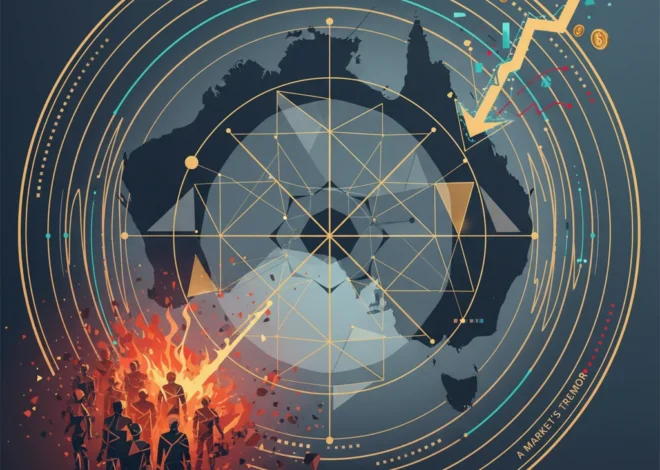
Nuclear Ambitions, Market Tremors: Decoding the Financial Fallout of Renewed Weapons Testing
The Unthinkable Return: Why a Decades-Old Nuclear Taboo is Back on the Table
In a move that sent ripples through diplomatic and financial circles, former US President Donald Trump has called for an “immediate” restart of nuclear weapons testing, a practice the United States has abstained from since 1992. This declaration, reported by the Financial Times, arrived just ahead of a crucial summit with China’s Xi Jinping, suggesting a high-stakes negotiating posture. For investors, business leaders, and financial professionals, this is far more than a political headline; it’s a potential seismic shift in the geopolitical landscape, carrying profound implications for the global economy, the stock market, and long-term investment strategies. The era of predictable, rules-based global order is being challenged, and the re-emergence of nuclear brinkmanship forces us to re-evaluate risk in ways not seen since the Cold War.
For over three decades, the global moratorium on nuclear testing has been a cornerstone of international security and non-proliferation efforts. While the U.S. never ratified the Comprehensive Nuclear-Test-Ban Treaty (CTBT) of 1996, it has honored its core tenets. A reversal of this long-standing policy would not occur in a vacuum. It would signal a new, more confrontational era of great power competition, directly impacting everything from international trade and supply chains to currency valuations and capital flows. Understanding the potential fallout is no longer a theoretical exercise for policy wonks; it’s an essential component of modern risk management and strategic financial planning.
The Geopolitical Chessboard: Context for a New Cold War
To grasp the financial implications, we must first understand the geopolitical context. Trump’s statement is not an isolated event but rather a reaction to a rapidly deteriorating global security environment. Two key developments set the stage for this dramatic proposal:
- Russia’s Strategic Shift: In late 2023, Russia officially de-ratified the CTBT, a move President Vladimir Putin described as necessary to “mirror” the position of the United States. While Moscow stated it would not resume testing unless the U.S. did so first, the legislative action dismantled a key pillar of post-Soviet arms control, giving Russia the flexibility to act swiftly. This has created a “permission structure” for other nations to reconsider their own commitments, raising the specter of a domino effect.
- China’s Arsenal Modernization: The Pentagon has repeatedly warned of China’s accelerated nuclear expansion. A 2023 report to Congress estimated that Beijing’s arsenal could exceed 1,000 operational warheads by 2030. According to the Federation of American Scientists, China’s stockpile has grown significantly in recent years, a pace that suggests an ambition to achieve nuclear parity with both Russia and the U.S. (source). This rapid modernization is the primary justification cited by proponents of resuming U.S. testing, who argue that existing stockpile stewardship programs, which rely on simulations, may be insufficient to guarantee the reliability of new warhead designs needed for effective deterrence.
Resuming testing would be a powerful, albeit deeply controversial, signal to both Beijing and Moscow. It would aim to demonstrate American resolve and technological superiority, potentially forcing competitors into a costly arms race they are ill-equipped to win. However, it would also likely shatter the global non-proliferation regime, alienate key allies, and introduce a terrifying new variable into the global risk equation.
The End of an Era: Navigating the "Messy" Transition to a Post-American World
Economic Tremors: From Treaties to Trading Floors
The transition from geopolitical posturing to tangible economic impact would be swift and severe. Investors and business leaders must prepare for a series of cascading effects that would reshape market dynamics.
1. A Surge in Market Volatility and Defense Spending
The most immediate and predictable reaction would be a spike in market volatility. The CBOE Volatility Index (VIX), often called the market’s “fear gauge,” would likely soar as uncertainty takes hold. In this “risk-off” environment, capital would flow out of cyclical sectors like technology and consumer discretionary and into traditional safe havens: U.S. Treasuries, gold, the Swiss franc, and the Japanese yen.
Simultaneously, the defense and aerospace sector would experience a significant re-rating. Companies like Lockheed Martin (LMT), Northrop Grumman (NOC), and RTX Corporation (RTX) would be direct beneficiaries. A resumption of testing implies a massive increase in the U.S. defense budget, not only for the tests themselves but for the development of new warhead designs and delivery systems. This would be a multi-decade tailwind for the industry. According to a recent analysis by the Congressional Budget Office, maintaining and modernizing the U.S. nuclear arsenal is already projected to cost over $750 billion over the next decade (source); a new arms race would send this figure skyrocketing.
The table below illustrates the potential performance divergence between the broader market and the defense sector during periods of heightened geopolitical tension.
| Event/Period | S&P 500 (SPY) Performance | Aerospace & Defense ETF (ITA) Performance | Analysis |
|---|---|---|---|
| First Month of Ukraine Invasion (Feb-Mar 2022) | -5.2% | +9.8% | Classic flight to safety and sector rotation into defense stocks. |
| Height of US-China Trade War (May 2019) | -6.4% | -2.1% | Defense showed relative outperformance as broader market sold off on trade fears. |
| Hypothetical Test Resumption (Projected) | -10% to -15% (Initial Shock) | +15% to +20% (Initial Rally) | Projected sharp divergence as markets price in higher global risk and massive defense budgets. |
2. Supply Chain Disruption and Currency Chaos
A more confrontational U.S. stance, particularly towards China, would severely disrupt global supply chains. The intricate web of global trade, already strained by the pandemic and trade wars, could begin to unravel. Industries reliant on Chinese manufacturing and rare earth minerals—from consumer electronics to electric vehicles—would face immense pressure. This would fuel inflation and dampen corporate earnings, creating headwinds for the broader stock market.
The currency markets would become a battleground. The U.S. dollar’s dual role as both a global reserve currency and the currency of a nation at the center of the instability would lead to volatile trading. While the dollar might initially strengthen on safe-haven demand, a long-term, fiscally draining arms race could ultimately undermine its global standing, leading savvy investors to seek alternatives.
Economic Warfare: Unpacking the US Sanctions on Russia's Energy Giants
Technology’s Role in a New Era of Deterrence
In this turbulent environment, technology, particularly fintech and blockchain, could play a pivotal and dual-edged role. On one hand, advanced financial technology platforms will be essential for institutional investors to model and hedge against these new tail risks. AI-driven sentiment analysis of geopolitical news and quantitative models that price in the probability of state-level conflict will become standard tools for any major investment bank or hedge fund.
On the other hand, the potential for state-level instability and the weaponization of the traditional banking system (via sanctions) could accelerate the search for non-sovereign assets. This is where blockchain technology and cryptocurrencies like Bitcoin enter the conversation. Proponents argue that a decentralized, borderless asset offers a unique hedge against the turmoil of a single nation-state. A world where major powers are actively engaging in nuclear brinkmanship is a world where investors may increasingly look to store a portion of their wealth outside the traditional financial system, beyond the reach of any single government.
The Investor’s Playbook for Unprecedented Uncertainty
Navigating this landscape requires a shift from a growth-at-all-costs mindset to a focus on capital preservation and strategic allocation. While it remains a hypothetical scenario, prudent investors should begin considering a playbook for this new reality.
- Strategic Sector Allocation: Overweight sectors that are resilient or stand to benefit from this environment. This includes Aerospace & Defense, Cybersecurity (as cyber warfare would escalate in tandem), and Energy (as conflicts disrupt global supply).
- Hard Asset Diversification: Increase allocations to gold and other precious metals, which have historically performed well during periods of extreme geopolitical stress and currency debasement.
- Geographic Hedging: Re-evaluate exposure to emerging markets, particularly those geographically and economically close to the epicenters of conflict. Favor stable, neutral jurisdictions.
- Active Risk Management: Employ options and other derivatives to hedge portfolio downside. Keep a close watch on volatility indicators and be prepared to reduce risk exposure quickly.
The call to restart nuclear testing may ultimately prove to be a negotiating tactic that is never acted upon. However, the fact that it is being discussed at the highest levels is a stark reminder that the post-Cold War “peace dividend” is over. The intersection of great power politics and the global economy is now a primary driver of market behavior. For those in finance, ignoring these signals is no longer an option. The tremors are already being felt, and the challenge is to fortify our portfolios before a potential earthquake.
The State Strikes Back: Why the Nexperia Takeover Signals a New Era for Global Investing
Conclusion: A New Paradigm for Risk and Return
The discussion around resuming nuclear testing is a watershed moment, forcing a re-evaluation of the foundational assumptions that have underpinned global economics and investing for a generation. It drags the unthinkable from the pages of history books into the realm of active risk management. Whether this rhetoric translates into policy or not, it has already altered the risk landscape. It underscores the fragility of our interconnected world and the profound impact that geopolitical decisions can have on financial markets. For business leaders, investors, and financial professionals, the key takeaway is clear: vigilance, strategic diversification, and a deep understanding of geopolitical risk are no longer optional—they are the essential price of admission for navigating the turbulent decade ahead.

